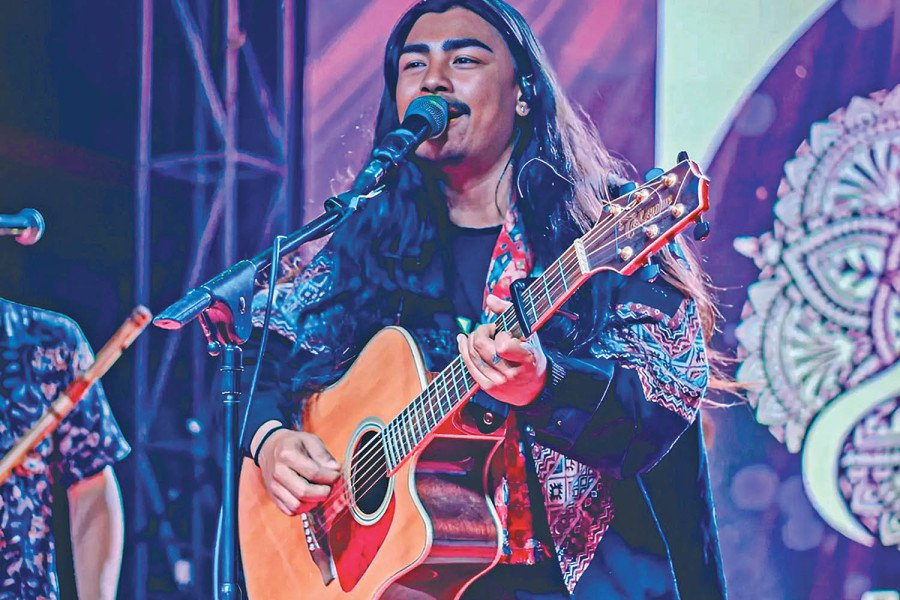Culture & Lifestyle
How Kuma Sagar writes songs
The singer blends traditional sounds and modern music, drawing inspiration from personal experiences and Newa culture.
Sanskriti Pokharel
For those in the creative industry, inspiration can strike at any moment. When Siddhi Sagar Prajapati, aka Kuma Sagar, was returning from his Gosainkunda trek, a few words began playing in his head. Having spent days in the mountains, his heart yearned for the comfort of his home and mother’s lap.
“Para bata sunda timro tyo boli mutu mai laagera manai ramaayo re,” (Hearing your voice from a distance touched my heart, making me happy,)
These words, born from the confluence of his longing towards his mother and the beauty of the surroundings, became the foundation for his song ‘A Mai Re’, which has more than 4.5 million views on YouTube.
Born and raised in Bhaktapur, Sagar’s musical journey seeds were sown early when he used to go to dafa (a Newa communal place for learning and playing traditional musical instruments) with his grandfather. The dafa hosted bhajan every evening in the falcha (Pati) of the community.
“My baje (grandfather) used to play Khing baja in the dafa, and I used to follow him. Since then, I have inclined towards music,” he shares. Sagar remembers singing ‘Chihan ki Pari’ for the first time in his school in 8th grade. Since childhood, he has analysed songs and music to understand how they were made.
However, like every typical Nepali parent, Sagar’s parents considered education the most crucial thing and hindered him from pursuing music. They ignored his desire to pursue an unconventional career and advised him to follow an orthodox job path.
His hours-long music practices with his friends were obstructed as his neighbours threw stones at him, saying he was producing unwanted, disturbing sounds.
Being the ‘chakchakey chora’ (troublemaker) who occasionally used to get involved in gang fights and class bunks, his parents even put him in ‘Home Rehab,’ forcing him to confront his choices. “During those difficult hours, I thought of changing my profession as I was earning neither money nor society’s approval through music. I even had thoughts about going abroad,” he says.
In 2019, Sagar got a call from The Voice of Nepal saying he had been selected. He remembers the pride reflected in his parents’ eyes during that moment. Although he did not win, his journey in the competition taught him a lot about music.
“I met many musicians, professional singers and experts in the Voice who inspired me,” he says. After the disqualification, Sagar planned to create his own music and songs.
Without equipment, he recorded his first song, 'Bajeko Bajang,' on his mobile phone in 2020. Sagar explains, "I would play the guitar and sing, recording both with my phone's mic and then edit the track using Adobe Premiere. For the drum beats, I relied on a vocal processor."
Till now, he has released seven songs.
Sagar's music is defined by its blend of traditional instruments and melodies. His work revitalises the ancient sounds of the Malla period, especially in songs like ‘Oh Champa’ and ‘Chahare Sari’, using instruments like Flute Dha, Bhusyah, and more. Infusing Newa culture into his compositions, Sagar employs the rhythms of the Bhajan Mandal and the flute and khing.
Sagar’s entire process, from writing lyrics to releasing a song, requires long hours of effort. Before starting any project, he creates a prototype of his songs and shares it with his team for feedback. His team assists in editing and refining the lyrics. He often gets spontaneous ideas for lyrics, whether walking down the street or riding a bike. He's constantly humming melodies and quickly jots it down whenever inspiration strikes.
"I need to keep my mind calm and clear. Only then can I work effectively. During the lockdown, there was a time when I worked on my computer for 24 hours straight, creating music without any sleep. I was enjoying experimenting with traditional musical instruments like the Basuri, Dha, Khing, and Dhimey," he shares.
‘Oh Champa’ is one of those Newa songs often played during jatras, adding vibrancy to the festivities. Including a section from the bhajan ‘Shree Rajendra’ in the final part of the song caught the audience's attention and made it a hit.
Then, his journey led him to Australia for his first international concert. On the same day, The Elements had a separate event, which made Prajapati expect a smaller audience. However, with around 500 tickets sold, he felt incredibly proud and happy while performing.
Sagar recalls a memorable fan encounter, “A kid in Thimi had been waiting to meet me, and when we finally met, he cried. It was the first time I had such an experience. People had praised and complimented me before, but no one had ever shed tears. I recently met that kid again—he's grown up a lot and has attended many of my concerts, always supporting me. Fans like him give me more energy and motivation.”
Sagar currently feels that he is where he belongs. Although the Nepali music industry may not have offered the support he expected, Prajapati remains steadfast. By releasing more songs infused with Newa culture, he hopes to inspire the next generation to continue the cultural and musical legacy, striving to preserve it for the future.
Kuma Sagar’s song recommendations
Chaubandi Cholo
Photo: Courtesy of Mukti and Revival
Band: Mukti and Revival
Year: 2000
I've been listening to this song since it came out. It was basically a blueprint of how songs should be made.
Bhul ma Bhulyo
Photo: Post Photo
Band: Robin n Looza
Year: 2001
I enjoy the drum beats in this song. They have a contagious energy that instantly gets people on their feet.
Chihan ki Pari
Photo: Screengrab Via YouTube
Artist: Shirish Khadka
Year: 2010
I have a special connection with this song as it was the first I played on guitar, during a school event.
Maryo ni Maryo ni
Photo: Courtesy of COBWEB
Band: COBWEB
Year: 2009
This song and the band brought a new style in the Nepali music industry. It's truly a masterpiece.
Taal ko Paani
Photo: Post Photo
Band: Nepathya
Year: 2003
When Nepathya performed this song at a Bhaktapur concert, the crowd’s energy inspired me to follow in the band’s footsteps.




 8.12°C Kathmandu
8.12°C Kathmandu















